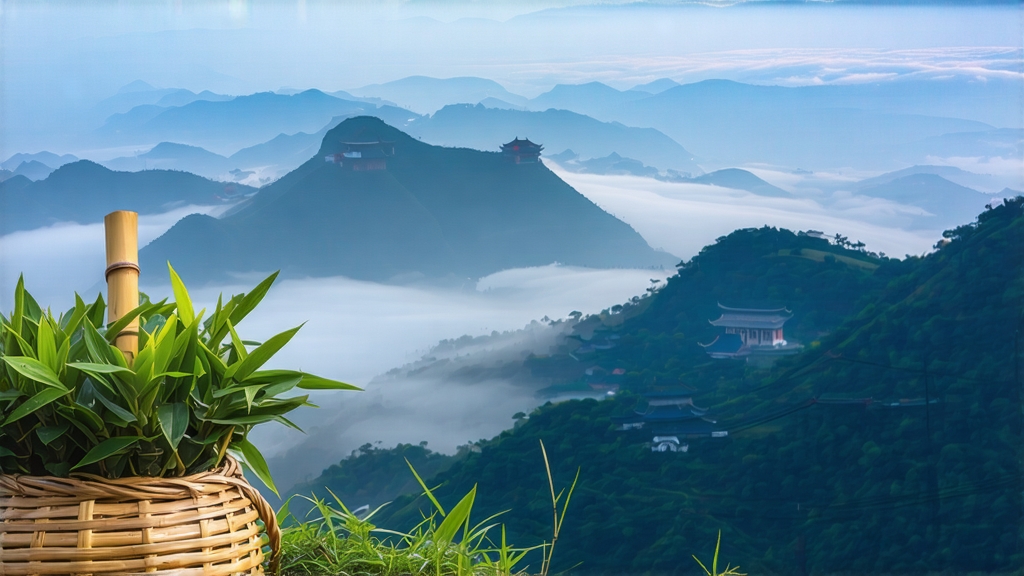
High on the mist-veiled shoulders of Mt. Mengding in Sichuan province, where clouds brush evergreen camellia trees and the air smells of pine and wild orchids, one of China’s most discreet treasures has been quietly thriving for more than twelve centuries. Mengding Huangya—literally “Yellow Bud from Mengding”—is the oldest documented yellow tea on record, yet it remains virtually unknown outside a small circle of connoisseurs. Unlike the assertive smoke of Lapsang or the floral bombast of Tie Guan Yin, Mengding Huangya speaks in whispers: a silky liquor the color of morning sunlight, a scent that hovers between fresh corn silk and mountain orchid, and a sweetness that arrives only after the third steeping, like a memory you did not know you had. To understand this tea is to step into the lost etiquette of Tang-dynasty court life, when tea bricks were currency and the first spring bud was reserved for the emperor himself.
Historical scrolls kept in the Ya’an City Archives record that Mengding tea was officially listed as “tribute” in 724 CE, when the monk Wu Lizhen planted seven tea bushes on the summit of Mt. Mengding and presented their spring picks to Emperor Xuanzong. The court quickly decreed that any yellow tea from this micro-region must pass through three gates of inspection—aroma, leaf shape, and liquor clarity—before it could travel the thousand-kilometer road to Chang’an. By the Song dynasty the tea had acquired its characteristic “yellow” hue thanks to a slow oxidation step later codified as men huang, “sealed yellowing.” Caravans carried it westward to Tibet, where monks traded yak butter for leaves that would enliven meditation; eastward it sailed to Kyoto, inspiring Japanese monks to create their own yellow-tinged teas. When the Qing court switched to darker, fully fermented cakes for ease of transport, Mengding Huangya retreated into the high mist, produced only for local scholars and the occasional poet seeking liquid inspiration.
Botanically the tea belongs to the small-leaf Camellia sinensis var. sinensis, but centuries of selection have produced a local cultivar nicknamed “yellow shoot” whose buds contain up to 6.8 % theanine, nearly double that of standard Longjing. The picking window is cruelly short: only three mornings around the Qingming festival when the bud is still closed like a grain of rice and the first leaf has not yet unfurled. A skilled picker can harvest barely 500 grams in a day; 50,000 buds are required for one kilo of finished tea. Because the mountain is frequently shrouded in fog, photosynthesis is gentle, yielding leaves rich in amino acids yet low in bitter catechins—the biochemical precondition for the tea’s signature umami sweetness.
The crafting choreography has changed little since Tang times. First comes the kill-green, but instead of the fierce 280 °C wok used for green tea, Mengding Huangya is laid on a bamboo tray suspended over a charcoal basin at 150 °C. The tea master fans the embers with a goose-feather fan, creating a convective heat that wilts the buds in exactly four minutes; any longer and the enzymatic pathway needed for yellowing is destroyed. While the leaves are still warm they are rolled—no machinery, just the heel of the palm pressing forward, backward, then a quarter turn, a motion said to mimic the writing of the Chinese character for “mountain.” Next comes the decisive step: the wrapped yellowing. The rolled buds are wrapped in thin cotton cloth, then in yellow paper once used for imperial edicts, and placed inside a bamboo steamer. The steamer is set over a brass basin holding exactly 200 ml of mountain spring water; a pine lid is lowered, and the tea sleeps for 48 hours at 35 °C and 85 % humidity. During this micro-fermentation chlorophyll degrades into pheophytin, catechins dimerize into theaflavins, and a hint of methyl anthranilate forms—the same compound that gives Concord grapes their foxy aroma. Finally the leaves are dried in three ascending temperatures: 60 °C to lock in shape, 80 °C to arrest enzymes, 100 °C to polish the surface. The finished tea resembles tiny golden fishhooks, each tipped with a pale down that glints when tilted toward light.
Water is the silent ingredient. The mountain spring that nourishes the